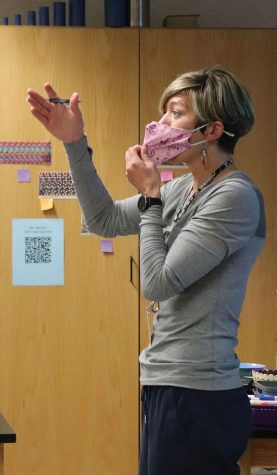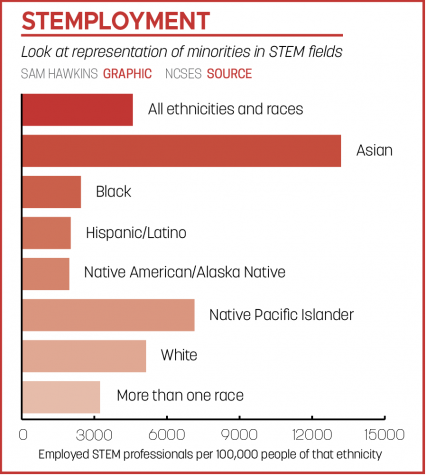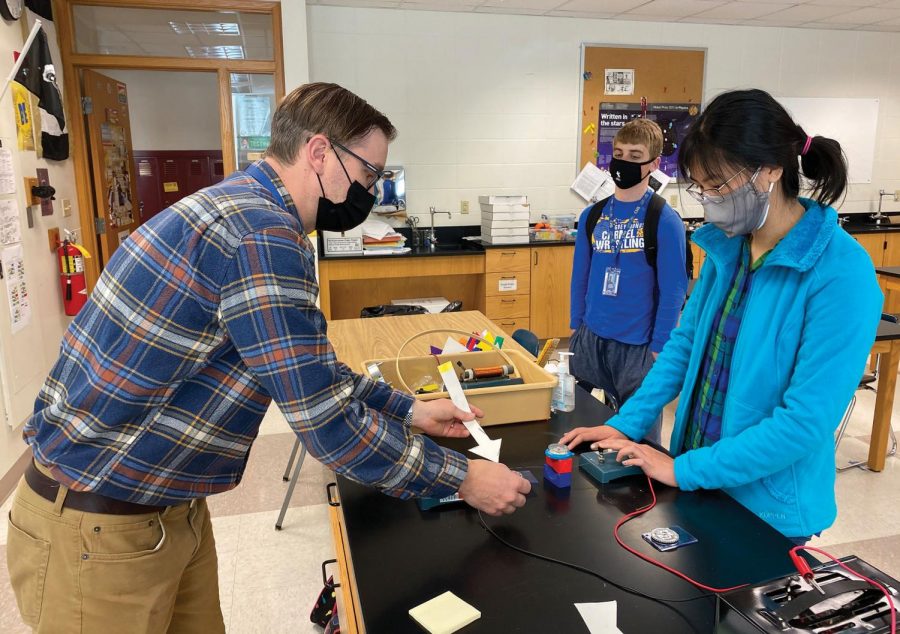For Briana Chen, Physics Club member and senior, extracurricular activities are important in exploring her passion: astrophysics. However, her passion does come with a drawback—stereotypes.
Chen said, “I do feel that kind of pressure in terms of being a female in a male-dominated space, especially when it comes to proving, proving myself as able to compete and make discoveries or solve problems. I feel like there is that kind of indirect effect, but, directly, I’ve been lucky to not have experienced that.”
She is not alone in this sentiment. Popular culture’s stereotype of a scientist, often a socially-awkward male researching in a lab wearing goggles and a lab coat, in shows like “Bill Nye the Science Guy” and “Jimmy Neutron,” often does not include scientists of lesser known fields.
This stereotype’s presence is also demonstrated through the Draw-A-Scientist Test, first developed by David Wade Chambers, who utilized this method in his landmark study conducted between 1966 and 1977 to test mostly American and Canadian children’s perceptions of a scientist by asking them to draw a picture of a scientist. The results of this test showed that the majority of children, 99.4%, associated science with males, often in a lab, wearing goggles and a lab coat, as well as having facial hair.
Science department chair Jennifer Drudge said being cognizant of this environment is imperative for teachers to combat such stereotypes.

“I think for me as a teacher, (science being male-dominated) just makes me aware that everything we do as teachers matters. What kids hear from us, if they hear us talking about men that are physicists or men that are doing this, they also need to hear about women who are doing all those things as well; that’s both (gender-related) and race-related,” Drudge said. “We can all be and do anything we want to be and it’s important for us to voice that and communicate that to students.”
Moreover, Chen said this portrayal of science in popular culture causes an increased embracing of such stereotypes regarding the appearance of scientists by those who are not involved in science.
“(Science) is not just a nerdy thing about like, ‘Oh, I like, I like looking at stars’ or something,” she said. “It’s more like, ‘What I’m doing could make an impact on how we view the world and stuff, even if it still hasn’t reached like a wide audience.’”
Furthermore, a 2018 study funded by the National Science Foundation Graduate Research Fellowship holistically analyzed the results of this landmark study and other Draw-A-Scientist studies from 1985 to 2016. According to the analysis, while the percentage of children who drew a female scientist grew from 1% to 28%, children still relate science to males as they grow older, which may be due to increased access to pop culture mass media and that formal science instruction does not begin until late elementary school to middle school. The environment in which students garner formal science instruction is important in shaping their view of what a scientist looks like.
Moreover, as per Glenn Branch, Deputy Director at the National Center for Science Education, many of these stereotypes permeate in different ways and can cause students to be alienated from the field if they are continuously exposed to them
“(Demography, psychology, and topic) plausibly hinder science education. Insofar as they accept the stereotype, students who are female and/or not white and students who don’t want to be thought of as nerdy will be alienated from science,” Branch said via email. “They will find it less interesting, not as relevant to people like them, and be deterred from further study or possible careers in scientific fields. And students who aren’t interested in lab work will be less likely to be interested in science if they don’t realize that science also takes place in other venues—in the field, as with biologists and geologists, or in the study, as with theoretical physics and the like.”
Branch said social media is one of the major contributing factors to the spread of stereotypes as opposed to science education itself; most people tend to be exposed to social media and pop culture more often compared to science textbooks, and most (good) textbooks focus more on principles rather than perception. However, there are some notable social media accounts that serve to combat this, such as @BlackinBioAnth (highlighting Black biological anthropologists) and @BlackinMarSci (highlighting Black marine scientists) on Twitter.
Undoubtedly, for Chen, who is interested in astrophysics, past achievements such as the first photograph ever taken of a black hole back in 2019 and the first image of a black hole’s magnetic field, which was completed in late March of this year, are also helping to counter science education stereotypes and demonstrate the interdisciplinary nature of different scientific fields.

Drudge said, “This past year, one of the good things that have come out of the COVID pandemic has been that we are getting to see scientists, and we’re getting to see scientists in press conferences at the White House. We’re getting to see scientists on the news and what you see is there’s a whole variety of scientists, just like there’s a whole variety of guys in the NBA or women in the WNBA—there doesn’t have to be one stereotype. I do think that’s a good thing that’s come out of the COVID pandemic: more awareness of what a scientist looks like and what a scientist looks like, like any other occupation.”
Chen said she agreed.
She said, “I feel like discoveries in astronomy, maybe they won’t be an everyday thing in everybody’s lives, but I think it’s definitely gotten better over the years in terms of people actually being exposed to it instead of just not knowing about it at all.”
Read Q&As with CHS women in STEM here

































![What happened to theater etiquette? [opinion]](https://hilite.org/wp-content/uploads/2025/04/Entertainment-Perspective-Cover-1200x471.jpg)













































![Review: “The Immortal Soul Salvage Yard:” A criminally underrated poetry collection [MUSE]](https://hilite.org/wp-content/uploads/2025/03/71cju6TvqmL._AC_UF10001000_QL80_.jpg)
![Review: "Dog Man" is Unapologetically Chaotic [MUSE]](https://hilite.org/wp-content/uploads/2025/03/dogman-1200x700.jpg)
![Review: "Ne Zha 2": The WeChat family reunion I didn’t know I needed [MUSE]](https://hilite.org/wp-content/uploads/2025/03/unnamed-4.png)
![Review in Print: Maripaz Villar brings a delightfully unique style to the world of WEBTOON [MUSE]](https://hilite.org/wp-content/uploads/2023/12/maripazcover-1200x960.jpg)
![Review: “The Sword of Kaigen” is a masterpiece [MUSE]](https://hilite.org/wp-content/uploads/2023/11/Screenshot-2023-11-26-201051.png)
![Review: Gateron Oil Kings, great linear switches, okay price [MUSE]](https://hilite.org/wp-content/uploads/2023/11/Screenshot-2023-11-26-200553.png)
![Review: “A Haunting in Venice” is a significant improvement from other Agatha Christie adaptations [MUSE]](https://hilite.org/wp-content/uploads/2023/11/e7ee2938a6d422669771bce6d8088521.jpg)
![Review: A Thanksgiving story from elementary school, still just as interesting [MUSE]](https://hilite.org/wp-content/uploads/2023/11/Screenshot-2023-11-26-195514-987x1200.png)
![Review: "When I Fly Towards You", cute, uplifting youth drama [MUSE]](https://hilite.org/wp-content/uploads/2023/09/When-I-Fly-Towards-You-Chinese-drama.png)
![Postcards from Muse: Hawaii Travel Diary [MUSE]](https://hilite.org/wp-content/uploads/2023/09/My-project-1-1200x1200.jpg)
![Review: "Ladybug & Cat Noir: The Movie," departure from original show [MUSE]](https://hilite.org/wp-content/uploads/2023/09/Ladybug__Cat_Noir_-_The_Movie_poster.jpg)
![Review in Print: "Hidden Love" is the cute, uplifting drama everyone needs [MUSE]](https://hilite.org/wp-content/uploads/2023/09/hiddenlovecover-e1693597208225-1030x1200.png)
![Review in Print: "Heartstopper" is the heartwarming queer romance we all need [MUSE]](https://hilite.org/wp-content/uploads/2023/08/museheartstoppercover-1200x654.png)



